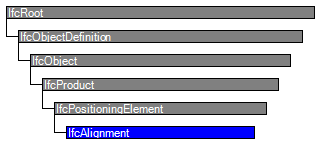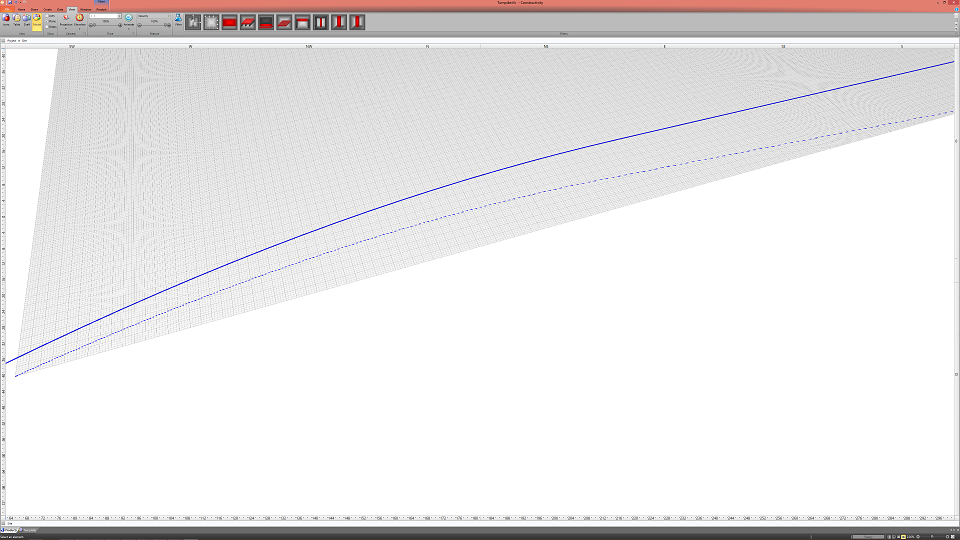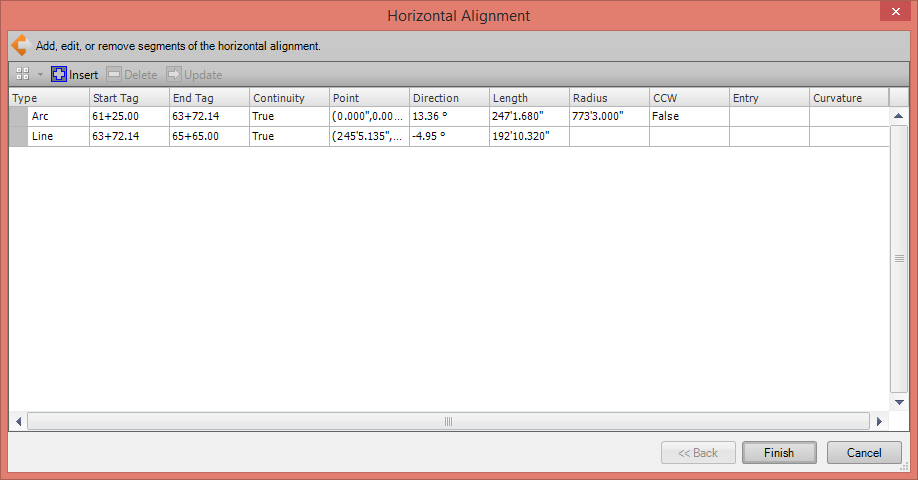Inherited definitions from supertypes
Entity inheritance

Attribute inheritance
| # | Attribute | Type | Cardinality | Description | B |
|---|---|---|---|---|---|
| IfcRoot | |||||
| 1 | GlobalId | IfcGloballyUniqueId | [1:1] | Assignment of a globally unique identifier within the entire software world. | X |
| 2 | OwnerHistory | IfcOwnerHistory | [0:1] |
Assignment of the information about the current ownership of that object, including owning actor, application, local identification and information captured about the recent changes of the object,
NOTE only the last modification in stored - either as addition, deletion or modification. | X |
| 3 | Name | IfcLabel | [0:1] | Optional name for use by the participating software systems or users. For some subtypes of IfcRoot the insertion of the Name attribute may be required. This would be enforced by a where rule. | X |
| 4 | Description | IfcText | [0:1] | Optional description, provided for exchanging informative comments. | X |
| IfcObjectDefinition | |||||
| HasAssignments | IfcRelAssigns @RelatedObjects | S[0:?] | Reference to the relationship objects, that assign (by an association relationship) other subtypes of IfcObject to this object instance. Examples are the association to products, processes, controls, resources or groups. | X | |
| Nests | IfcRelNests @RelatedObjects | S[0:1] | References to the decomposition relationship being a nesting. It determines that this object definition is a part within an ordered whole/part decomposition relationship. An object occurrence or type can only be part of a single decomposition (to allow hierarchical strutures only). | ||
| IsNestedBy | IfcRelNests @RelatingObject | S[0:?] | References to the decomposition relationship being a nesting. It determines that this object definition is the whole within an ordered whole/part decomposition relationship. An object or object type can be nested by several other objects (occurrences or types). | X | |
| HasContext | IfcRelDeclares @RelatedDefinitions | S[0:1] | References to the context providing context information such as project unit or representation context. It should only be asserted for the uppermost non-spatial object. | ||
| IsDecomposedBy | IfcRelAggregates @RelatingObject | S[0:?] | References to the decomposition relationship being an aggregation. It determines that this object definition is whole within an unordered whole/part decomposition relationship. An object definitions can be aggregated by several other objects (occurrences or parts). | X | |
| Decomposes | IfcRelAggregates @RelatedObjects | S[0:1] | References to the decomposition relationship being an aggregation. It determines that this object definition is a part within an unordered whole/part decomposition relationship. An object definitions can only be part of a single decomposition (to allow hierarchical strutures only). | X | |
| HasAssociations | IfcRelAssociates @RelatedObjects | S[0:?] | Reference to the relationship objects, that associates external references or other resource definitions to the object.. Examples are the association to library, documentation or classification. | X | |
| IfcObject | |||||
| 5 | ObjectType | - | This attribute is out of scope for this model view definition and shall not be set. | ||
| IsTypedBy | IfcRelDefinesByType @RelatedObjects | S[0:1] | Set of relationships to the object type that provides the type definitions for this object occurrence. The then associated IfcTypeObject, or its subtypes, contains the specific information (or type, or style), that is common to all instances of IfcObject, or its subtypes, referring to the same type. | X | |
| IsDefinedBy | IfcRelDefinesByProperties @RelatedObjects | S[0:?] | Set of relationships to property set definitions attached to this object. Those statically or dynamically defined properties contain alphanumeric information content that further defines the object. | X | |
| IfcProduct | |||||
| 6 | ObjectPlacement | IfcObjectPlacement | [0:1] | Placement of the product in space, the placement can either be absolute (relative to the world coordinate system), relative (relative to the object placement of another product), or constraint (e.g. relative to grid axes). It is determined by the various subtypes of IfcObjectPlacement, which includes the axis placement information to determine the transformation for the object coordinate system. | X |
| 7 | Representation | IfcProductRepresentation | [0:1] | Reference to the representations of the product, being either a representation (IfcProductRepresentation) or as a special case a shape representations (IfcProductDefinitionShape). The product definition shape provides for multiple geometric representations of the shape property of the object within the same object coordinate system, defined by the object placement. | X |
| ReferencedBy | IfcRelAssignsToProduct @RelatingProduct | S[0:?] | Reference to the IfcRelAssignsToProduct relationship, by which other products, processes, controls, resources or actors (as subtypes of IfcObjectDefinition) can be related to this product. | X | |
| IfcPositioningElement | |||||
| PositionsElements | IfcRelPositions @RelatedPositioningElement | S[:?] | Elements positioned by this definition. | ||
| IfcAlignment | |||||
| 8 | PredefinedType | IfcAlignmentTypeEnum | [0:1] |
Specific type of the linear referencing method applicable to this alignment.
NOTE Only absolute linear referencing methods are supported by this specification. | X |
| 9 | Horizontal | IfcAlignment2DHorizontal | [0:1] | Provision of a horizontal alignment being an ordered list of horizontal alignment segments. | X |
| 10 | Vertical | IfcAlignment2DVertical | [0:1] | Provision of a vertical alignment being an ordered list of vertical alignment segments. | X |
| 11 | LinearRefMethod | IfcLabel | [0:1] |
Descriptive names for the Linear Referencing Method used to position items along the alignment. Examples are “Chainage”, “Milepoint”, "Kilometer-point". Only absolute linear referencing methods are currently supported by this specification.
NOTE The internal lenght unit, whether meter, kilometer, miles, feet, etc. are defined by the IfcUnitAssignment and do not depend on this descriptive name. | X |
Definitions applying to Bridge View
Horizontal and vertical alignment curves provide the underlying placement for all components in a bridge plan. For terminology, some software applications (e.g. Bentley LEAP Bridge) refer to Horizontal Alignment as simply “Alignment”, and Vertical Alignment as “Profile”, whereas this document and referenced standards use the term “Profile” to mean any arbitrary cross-section that may be applied in any direction. The deck surface cross-section is considered to be a “Profile” which is not part of the alignment itself but may be used in conjunction with the alignment to derive the overall 3D shape of the bridge deck. For all terms used within this document, refer to the Terms section of this specification for the specific meanings.

|
Figure 1 — Bridge alignment plans |
In this example in Figure 1, the origin of the horizontal alignment curve is considered to be the first station, having notation “61+25.00” as commonly used in the U.S. for indicating 6125.0 feet as a reference offset location. The particular placement referencing used results in both abutments lining up at the Y=0 location on Cartesian axis.

|
Figure 2 — Bridge alignment model |
Figure 2 shows the horizontal alignment curve (dotted line relative to the grid), and the vertical alignment curve (projected above the horizontal curve at constant slope). All components are positioned relative to either the horizontal alignment (e.g. piers and abutments) or the vertical alignment (e.g. girders, deck, and terrain for approaches).
For this example, the horizontal alignment curve is comprised of a horizontal curve consisting of a circular arc segment and a linear segment.

|
Figure 3 — Bridge alignment horizontal curve |
A vertical curve is also defined with a starting elevation and constant slope, which corresponds to the outer lane marking on the roadway surface.

|
Figure 4 — Bridge alignment vertical curve |
Concept usage
Alignment Attributes
The Alignment Attributes concept applies to this entity.
The alignment, is to be used for linear referencing, shall have a Horizontal alignment, in addition, if may have a Vertical alignment to provide the vertical profile along the alignment. The PredefinedType determines the linear referencing method type applicable to the alignment, the LinearRefMethod may add an additional descriptive name to the linear referencing method type.
Product Local Placement
The Product Local Placement concept applies to this entity.
Definition of the alignment object placement establishing the object coordinate system.
There should not be a derivation between the alignment coordinate system and the project engineering coordinate system. Therefore:
- No local placement should be provided, or
- if provided, the location shall be set to 0.,0.,0. with no rotation
Surface BSpline Geometry
The Surface BSpline Geometry concept applies to this entity.
To indicate a reference surface describing superelevation, an optional IfcSurface may be defined along the vertical alignment curve. While any arbitrary surface may be used, IfcRationalBSplineSurfaceWithKnots is recommended, taking the form of a ruled surface.
| Exchange | ||||
|---|---|---|---|---|
| Import | O | |||
| Export | O |
Concept inheritance
| # | Concept | Model View |
|---|---|---|
| IfcRoot | ||
| Software Identity | Bridge View | |
| User Identity | Bridge View | |
| Object Ownership | Bridge View | |
| IfcObject | ||
| Property Sets for Objects | Bridge View | |
| IfcAlignment | ||
| Alignment Attributes | Bridge View | |
| Product Local Placement | Bridge View | |
| Surface BSpline Geometry | Bridge View | |
Formal representations
XSD Specification
<xs:element name="IfcAlignment" type="ifc:IfcAlignment" substitutionGroup="ifc:IfcPositioningElement" nillable="true"/>
<xs:complexType name="IfcAlignment">
<xs:complexContent>
<xs:extension base="ifc:IfcPositioningElement">
<xs:sequence>
<xs:element name="Horizontal" type="ifc:IfcAlignment2DHorizontal" nillable="true" minOccurs="0"/>
<xs:element name="Vertical" type="ifc:IfcAlignment2DVertical" nillable="true" minOccurs="0"/>
</xs:sequence>
<xs:attribute name="PredefinedType" type="ifc:IfcAlignmentTypeEnum" use="optional"/>
<xs:attribute name="LinearRefMethod" type="ifc:IfcLabel" use="optional"/>
</xs:extension>
</xs:complexContent>
</xs:complexType>
EXPRESS Specification
ENTITY IfcAlignment
SUBTYPE OF (IfcPositioningElement);
PredefinedType : OPTIONAL IfcAlignmentTypeEnum;
Horizontal : OPTIONAL IfcAlignment2DHorizontal;
Vertical : OPTIONAL IfcAlignment2DVertical;
LinearRefMethod : OPTIONAL IfcLabel;
WHERE
ValidCombination : (EXISTS(Horizontal) AND EXISTS(Vertical)) OR
(EXISTS(Horizontal) AND NOT(EXISTS(Vertical))) OR
(NOT(EXISTS(Horizontal)) AND NOT(EXISTS(Vertical)));
END_ENTITY;
 Instance diagram
Instance diagram Link to this page
Link to this page